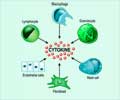Researchers at the NYU Medical Center believe that a new vaccine can harness the immune system in Alzheimer
Researchers at the NYU Medical Center believe that a new vaccine can harness the immune system in Alzheimer. The vaccine can fight the pathological form of tau protein, a key protein related to Alzheimer’s disease.
The researchers created the vaccine in mice that suppresses aggregates of tau protein which otherwise amasses into dangerous tangles in the memory center of the brains of Alzheimer’s patients. The research was led by Einar Sigurdsson Ph.D., Assistant Professor of Psychiatry and Pathology at New York University School of Medicine.The vaccine successfully slowed the deterioration of motor abilities produced by excessive amounts of tau in the central nervous system of mice, according to the study published in the August 22, 2007 issue of the Journal of Neuroscience. Dr. Sigurdsson plans to conduct follow-up studies using mice that slowly develop tangles and cognitive impairments without movement problems.
The study used mice that were genetically engineered to produce abnormal tau proteins early in life. These became entangled in several regions of the central nervous system. The resulting loss of motor coordination was significantly reduced in those immunized with a specific piece of the detrimental tau protein. By producing antibodies that could enter the brain and bind to irregular tau, the immune system prevented their harmful aggregation and associated behavioral impairments.
“This approach may have extensive therapeutic implications because you can specifically target the problematic protein,” said Dr. Sigurdsson. “Tau aggregates are inside the cell, making it especially difficult to develop a therapy to target and clear them from the cell.” Alzheimer’s disease is estimated to affect five million Americans. While treatments exist that may modestly alleviate its symptoms, none delay or prevent the onset of the disease, according to the Alzheimer’s Association.
The disease is associated with neurons in the memory center of the brain becoming choked by the buildup of two types of proteins: tau, which turns destructive when it is prone to forming fibrous tangles, and amyloid beta. Compared to extracellular amyloid plaques, tau aggregates are confined inside of brain cells, making them more difficult to reach.
“It’s likely that there’s a synergism in the pathology,” said Dr. Sigurdsson. “Amyloid pathology may cause tau pathology and tau pathology might cause more amyloid pathology. What you have is a vicious cycle. If you can target both of these proteins you’ll likely have more efficacious treatment.”
Advertisement
In previously published studies and in ongoing work, Dr. Sigurdsson has been developing ways to target the amyloid beta peptide, the other major hallmark of Alzheimer’s disease. Those experiments employed a different but complementary approach and were performed in collaboration with NYU School of Medicine’s Thomas Wisniewski, M.D., Professor of Neurology, Pathology and Psychiatry, David Quartermain, Ph.D., Professor of Neurology and Neuroscience and Physiology and Blas Frangione, M.D., Ph.D., Professor of Pathology and Psychiatry.
Advertisement
The battery of behavioral tests at five and eight months of age showed that immunized mice performed better—they traveled faster during exploratory activity, exhibited better balance on a rotating rod and committed less foot-slips while traversing a narrow wooden beam. These mice were also found to have less tau protein tangles in the brain. Object-recognition test showed that immunized mice and their controls remained cognitively normal, although mental deficits were expected to appear after the maximum 8-month period allowed in the study.
The mice in the study also had tau aggregates in the hippocampus, a brain region important for cognition and memory. The vaccine cleared tangles in this region as well, suggesting the immunotherapy could improve cognition.
The antibodies raised by the vaccine must reach the brain by traversing the organ’s protective blockade, the blood brain barrier. “Normally antibodies aren’t getting into the brain in any large quantities,” said Dr. Sigurdsson. “In this animal model—and also in Alzheimer’s disease—there’s a breakdown of the blood brain barrier.
In addition, it is well established that neurons have receptors that can bind to and promote uptake of antibodies and our studies seem to indicate that sick neurons that are accumulating tau aggregates take up more antibodies than healthy neurons. The antibodies then end up at the site where they can interact with pathological tau protein in the neuron, and promote its clearance.”
Source-Eurekalert
BIN/J








